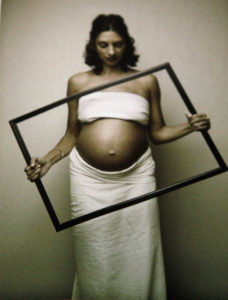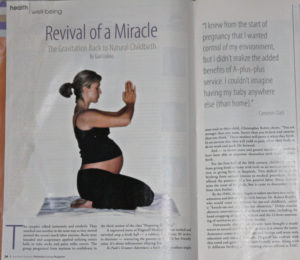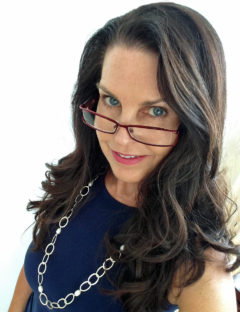![]() August 2008
August 2008
 The couples talked intimately, tenderly. They touched one another in the same way as they moved around the room’s mock labor stations. Backs were kneaded and acupressure applied, utilizing tennis balls in tube socks and paint roller covers. The group progressed from wariness to confidence in the third session of the class “Preparing for Baby.” A Registered Nurse at Flagstaff Medical Center rocked and swiveled atop a birth ball–a rubbery ball about 30 inches in diameter–reassuring the parents-to-be with her friendly voice. It’s about information allaying fear.
The couples talked intimately, tenderly. They touched one another in the same way as they moved around the room’s mock labor stations. Backs were kneaded and acupressure applied, utilizing tennis balls in tube socks and paint roller covers. The group progressed from wariness to confidence in the third session of the class “Preparing for Baby.” A Registered Nurse at Flagstaff Medical Center rocked and swiveled atop a birth ball–a rubbery ball about 30 inches in diameter–reassuring the parents-to-be with her friendly voice. It’s about information allaying fear.
In Pooh’s Greatest Adventure, a book these mothers might soon read to their children, Christopher Robin cheers, “You are stronger than you seem, braver than you believe and smarter than you think.” These mothers will prove it when they birth. In an ancient rite, these women will yield to pain, allow their body do its work and push life forward.
And in recent years and greater numbers, mothers have been able to empower themselves with natural childbirth.
For the first half of the 20th century, childbirth moved from giving birth at home with little to no medical intervention to giving birth in hospitals. This shifted the view of birthing from a natural process to a medical procedure, which offered the potential of a less painful labor. Many women went the route of hospitals, but it disconnected them from the bodies.
By the 1940’s, doctors began to sedate mothers into unconsciousness and deliver babies with forceps. Dr. Robert Bradley, who became an advocate for natural childbirth, called it “knock-em-out, drag-em-out obstetrics.” Other routine obstetric interventions had surfaced over time, including the hand-strapping of laboring women and the 12-hour monitoring of newborns away from the mother.
 Fortunately, the last few decades have brought a steady return to natural childbirth. These days, it is almost the norm. Assistance comes less with drugs and forceps, and more with education and natural methods. Flagstaff has evolved with this trend and grown into a birth-friendly town. Along with 11 different birthing and parenting classes offered at FMC, an established midwifery offers the home birth option—the least medical and most natural path.
Fortunately, the last few decades have brought a steady return to natural childbirth. These days, it is almost the norm. Assistance comes less with drugs and forceps, and more with education and natural methods. Flagstaff has evolved with this trend and grown into a birth-friendly town. Along with 11 different birthing and parenting classes offered at FMC, an established midwifery offers the home birth option—the least medical and most natural path.
Mary Ann Baul owns and works with certified professionals at Womancare Midwifery Center. She earned her midwifery degree in 1982 and became an RN a decade later. Her clients include professors, doctors, nurses and highly educated people who choose home birth for its specialized care.
“Eighty-seven percent of women with low-risk pregnancies are candidates for a home birth,” Baul said. Attentive care and early transport to FMC without haste accounts for the remainder. “Women self-select,” meaning they don’t opt for home births with conditions like lupus, high blood pressure or multiple pre-term history. She said, “I get the cream of the crop–women who are motivated to have a healthy and positive birth experience.”
Her hour-long appointments shape an intimate, holistic relationship that covers stress, family health, nutrition, and notably, empowering women. “I was born to do this,” Baul said.
When labor begins, a midwife and assistant evaluate the mother, bringing sterile equipment and supplies into the home. The team creates a sacred space for Mom–rubbing her back and feet, encouraging her to eat and drink and change position–yet not interfering. A second midwife arrives for the pushing stage. “At birth, Dad can help to receive or not or cut the cord or not,” Baul said.
When problems arise, Baul can resuscitate the baby, offer a whiff of oxygen–sometimes necessary at 7000 feet–stitch tears or even give an injection. Her team stays three to four hours after birth. Mom and baby are assessed and receive an herbal bath and poultices, breastfeeding assistance, a newborn physical, and later, a birth certificate. “Most people think birth is a huge mess,” she said, “but it’s not, and we do the laundry.”
Cameron Clark, Baul’s client and first-time mother to Owen, put it this way, “I knew from the start of pregnancy that I wanted control of my environment, but I didn’t realize the added benefits of A-plus-plus service. I couldn’t imagine having my baby anywhere else (than home).”
People may think home birth as anti-hospital, but perhaps this notion itself is dated because Flagstaff’s birthing community speaks of cooperation. Cindy Beckett, FMC’s Director of Pediatrics and Perinatal Services, appreciates midwives and Baul said, “I’m grateful for Labor and Delivery at FMC. Nursing works hard to be gracious to our clients.”
Sometimes the hospital route is needed and for some moms, it’s the more comforting option. When mothers-to-be birth at the medical center, they are given many more choices than mothers received half-a-century ago. “Our goal is to work with each family to allow them to have the optimal birth experience,” Beckett said.
Staff promotes aromatherapy, visualization, affirmations, music and relaxation techniques for the gentlest birth. “Bring things that will help you create a home environment,” Beckett said.
Mom typically stays 48 hours with Baby nestled in her private room, not carried away to a nursery. Education continues here with lessons on bathing and breastfeeding. Despite increased numbers of working women, more than 80 percent of mothers breastfeed, so certified lactation consultants are available 24 hours a day, even after discharge.
With nearly 1600 births at FMC last year, 60 percent of mothers required minimal intervention while 15 percent birthed naturally. Two surgical suites accommodate the unexpected, and a Special Care Level II Nursery stands ready. Still, natural childbirth is the aim. “Women need choices, and we provide a home-like birth with security. We have medical resources, but hopefully, they won’t need them,” Beckett concluded.
Either way, women have more power and more choices—so they can perform the miracle they have been created for. NAMLM Gail G. Collins
Editor’s Note: Gail Collins previously served as a childbirth educator for six years, and she is the mother of four children birthed naturally, two at home.
